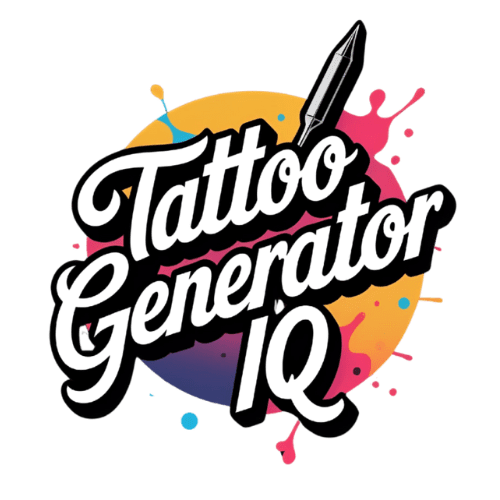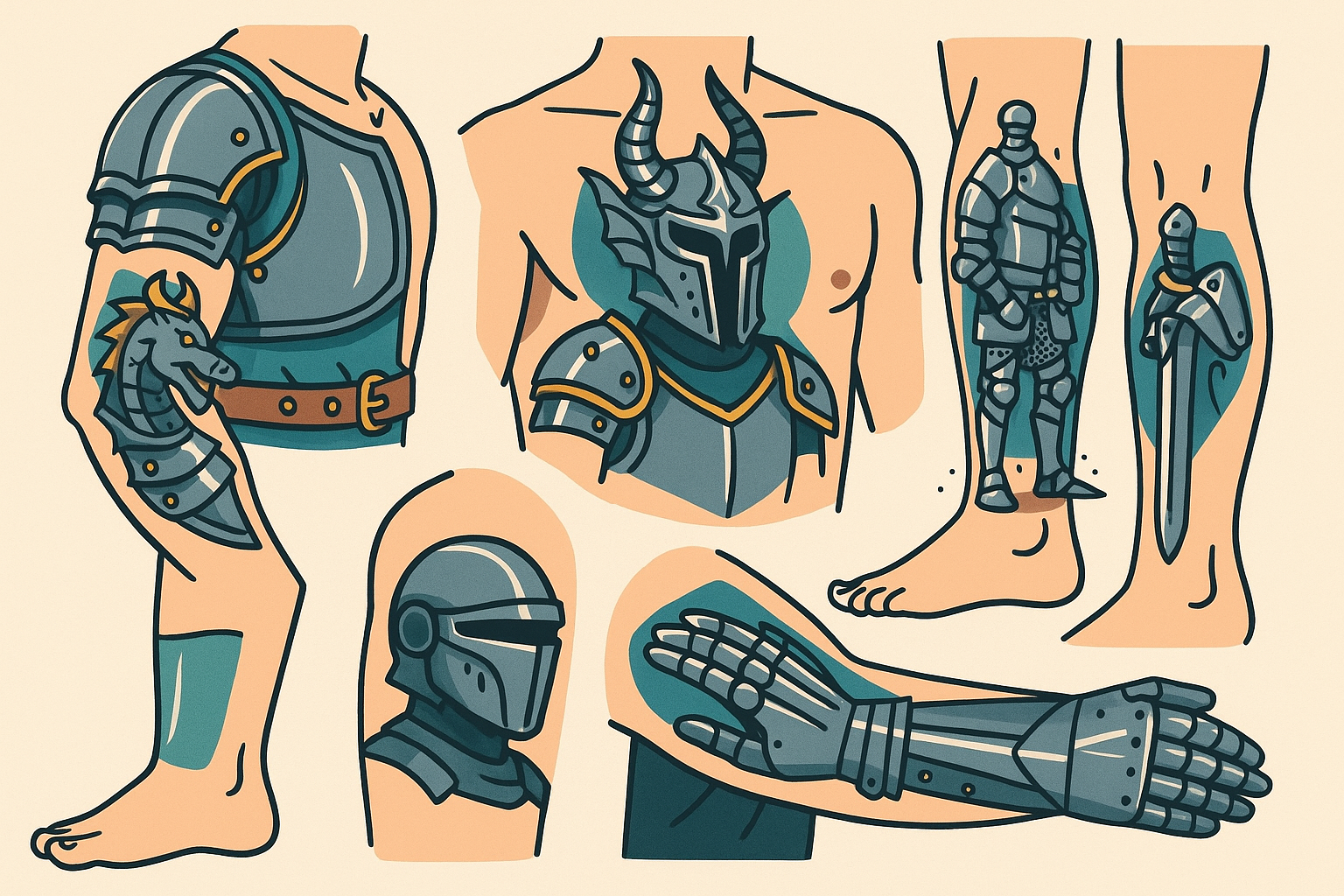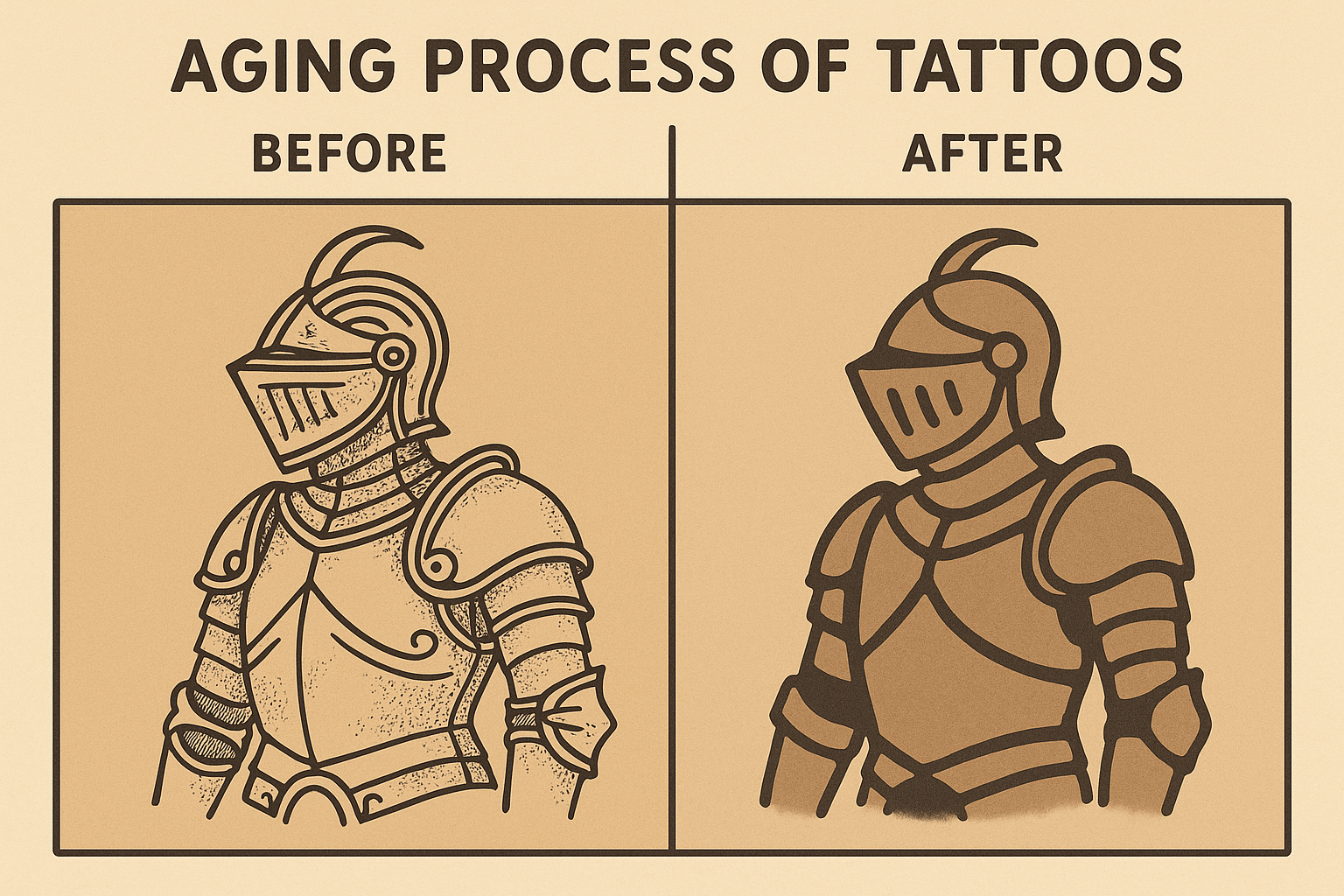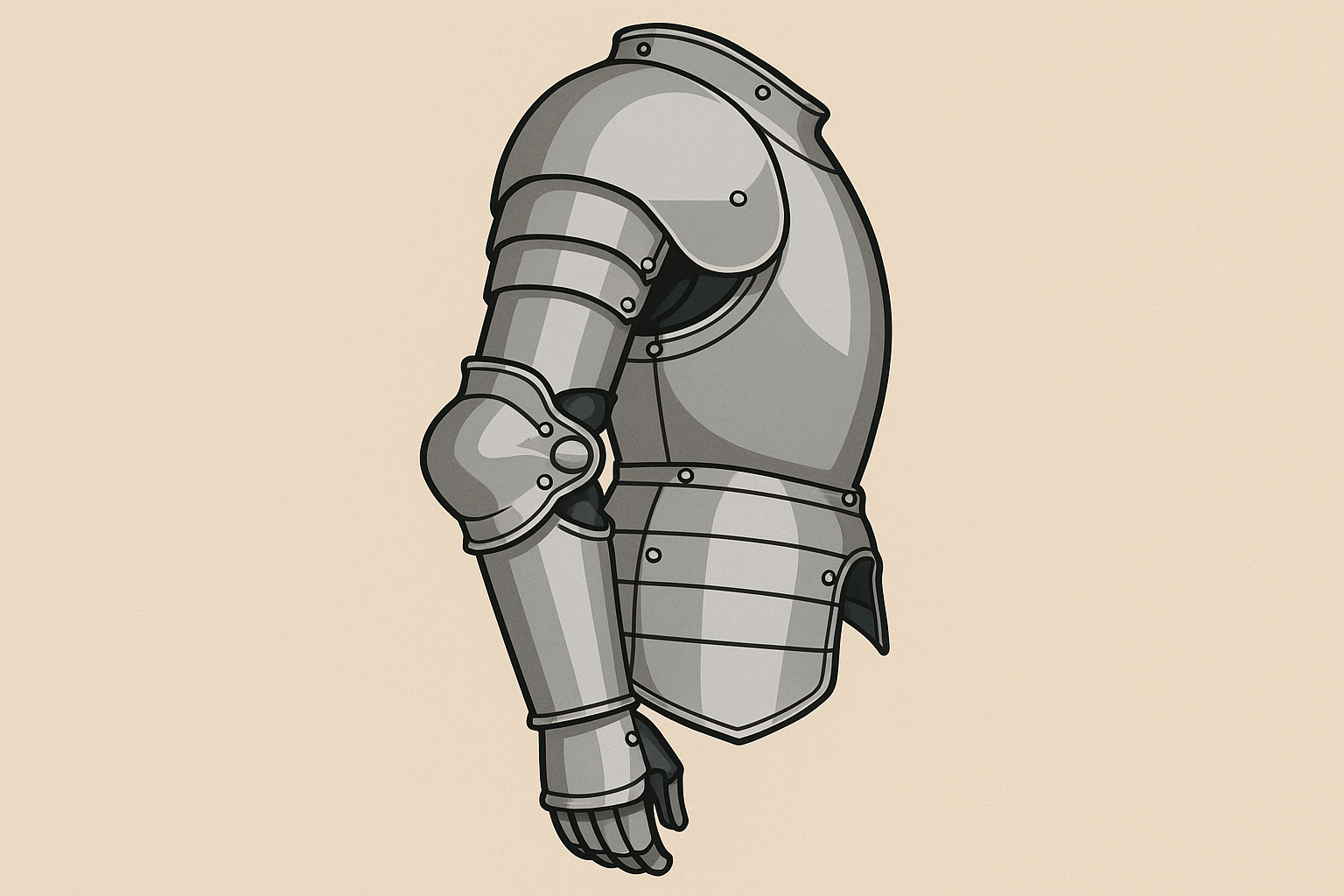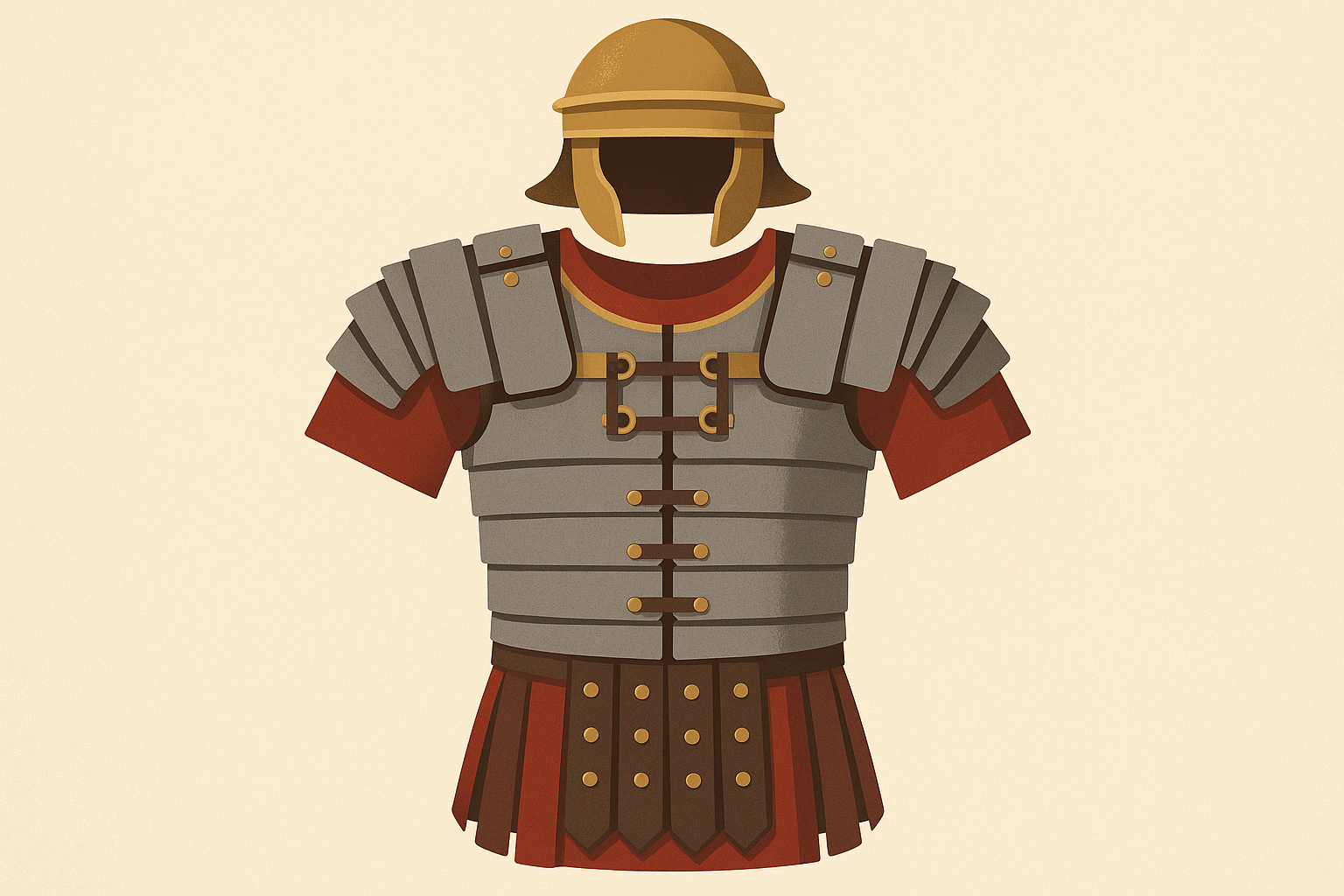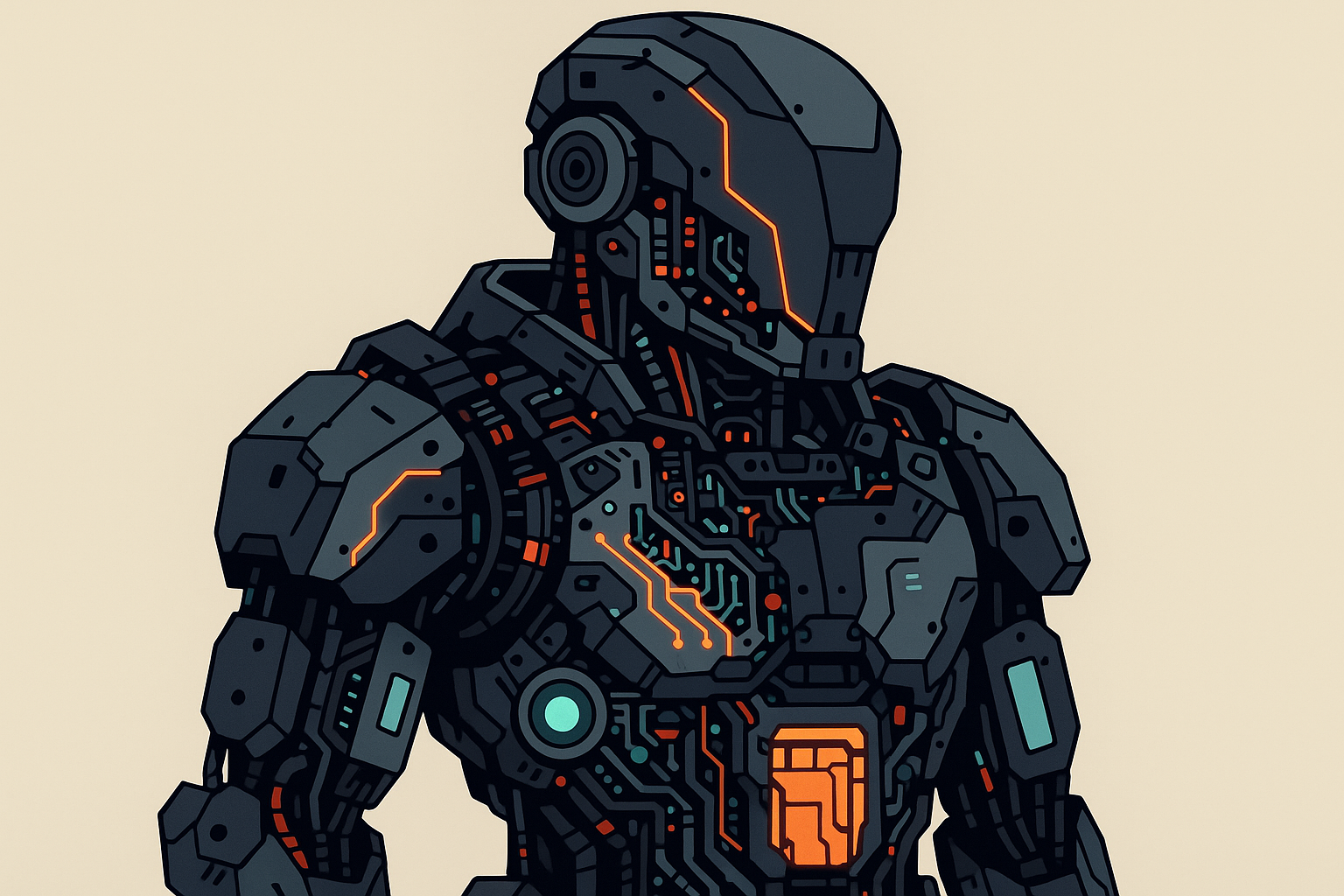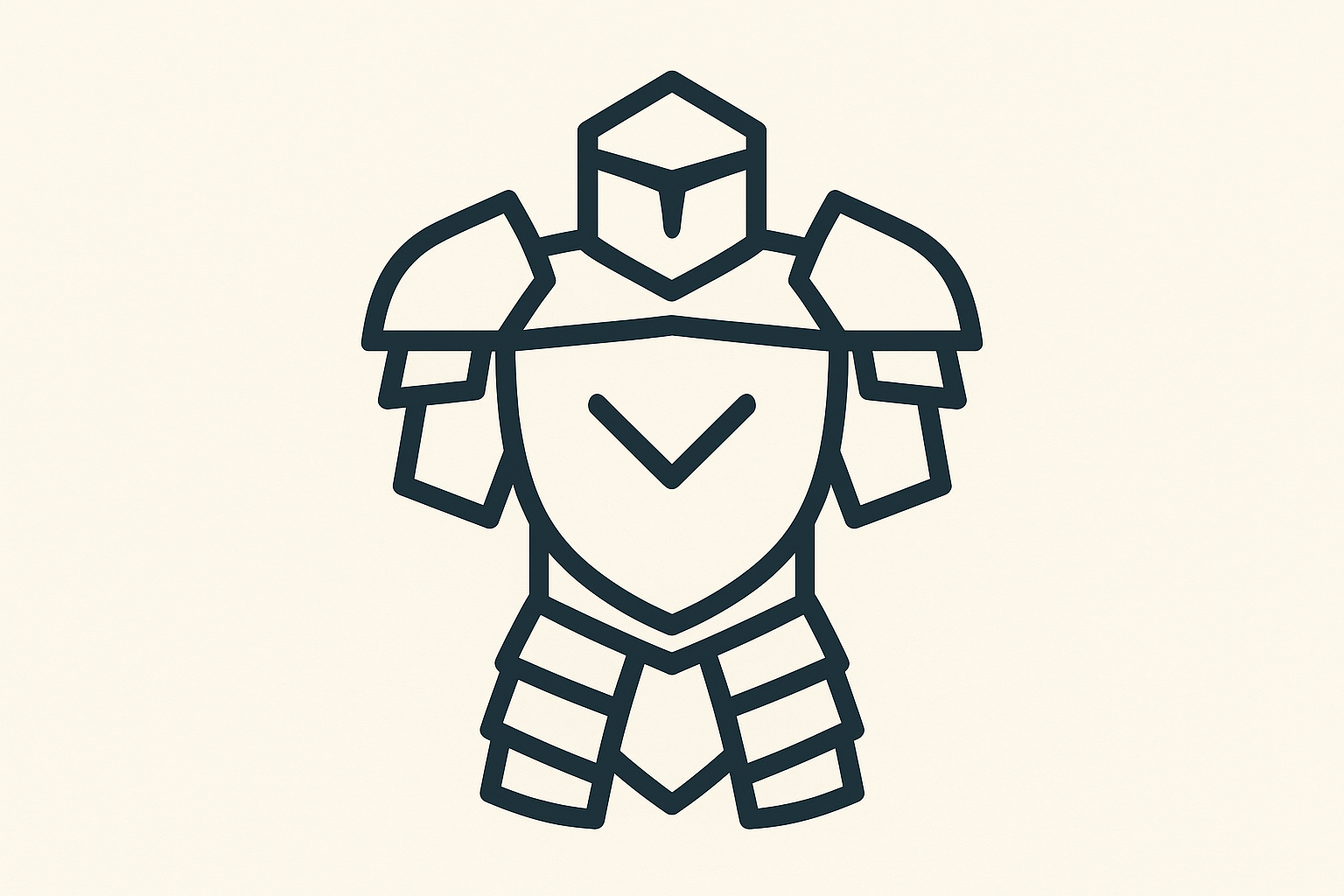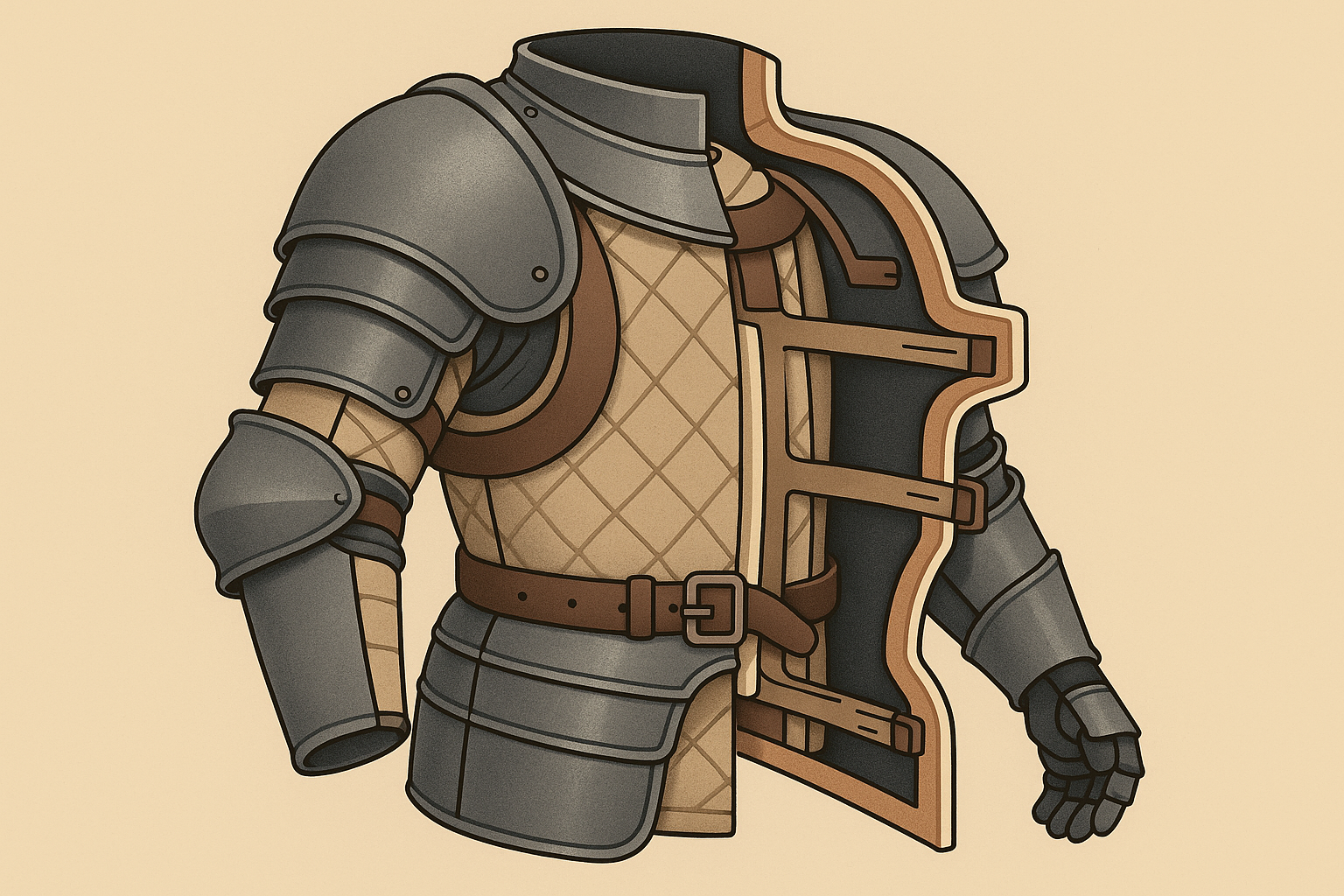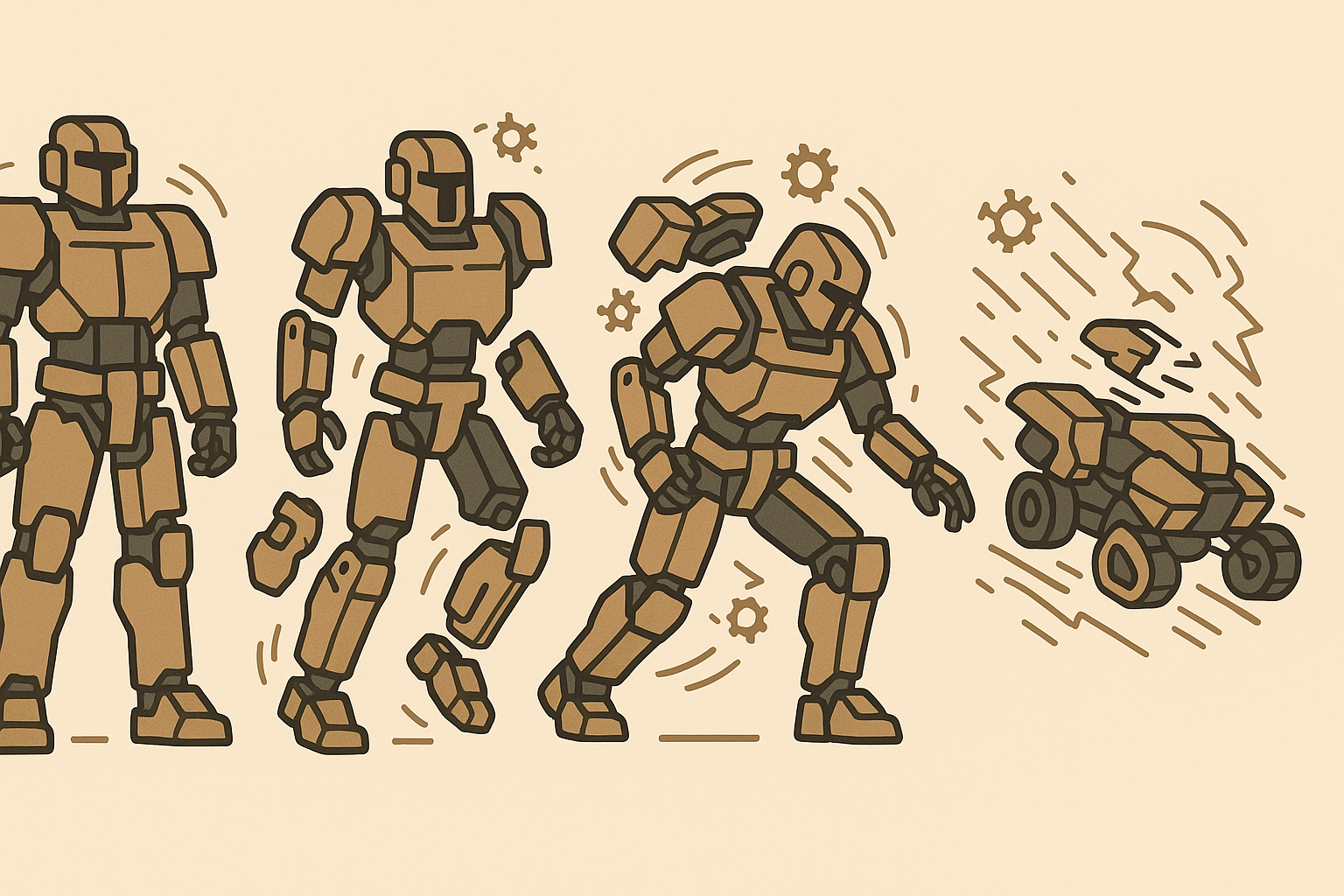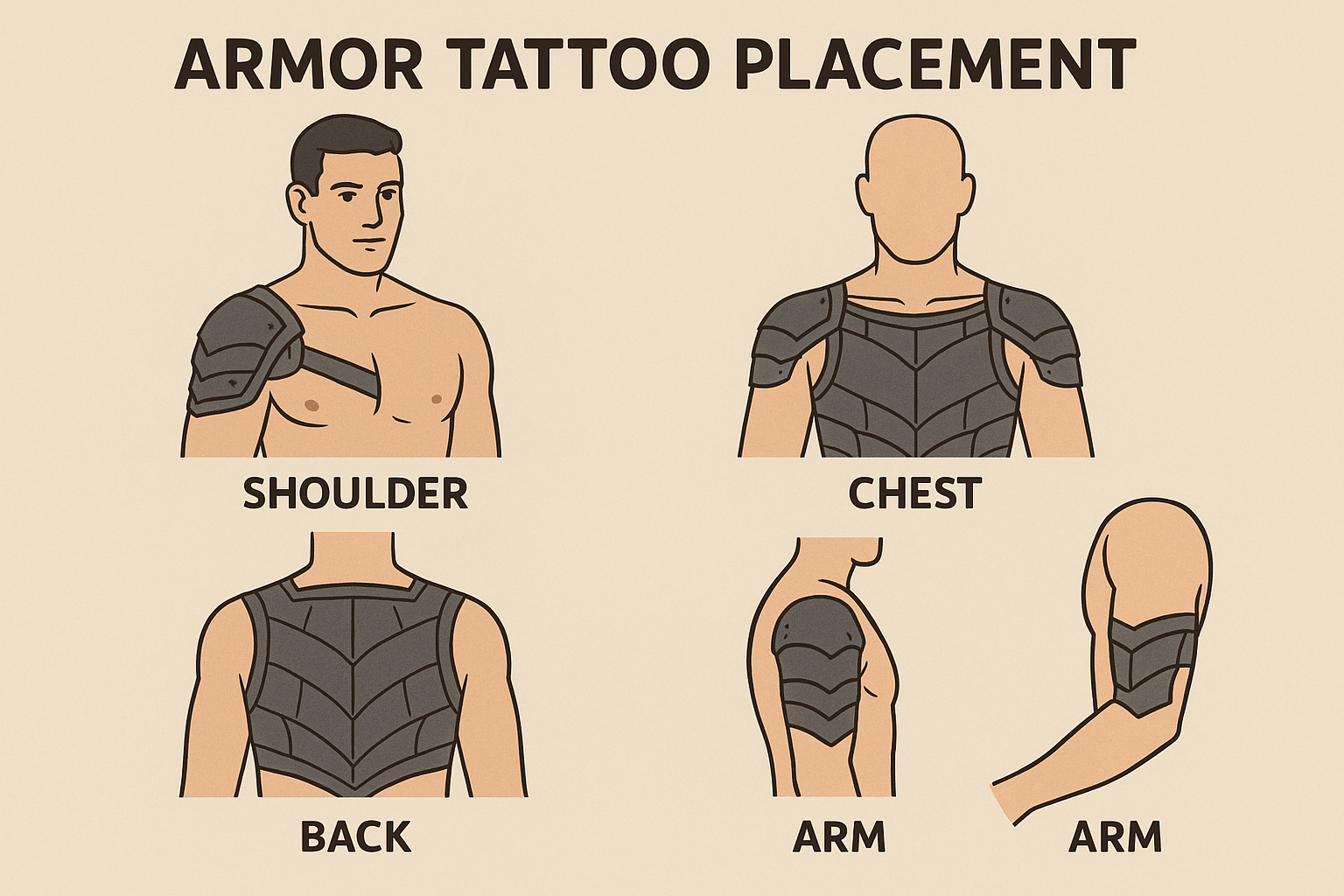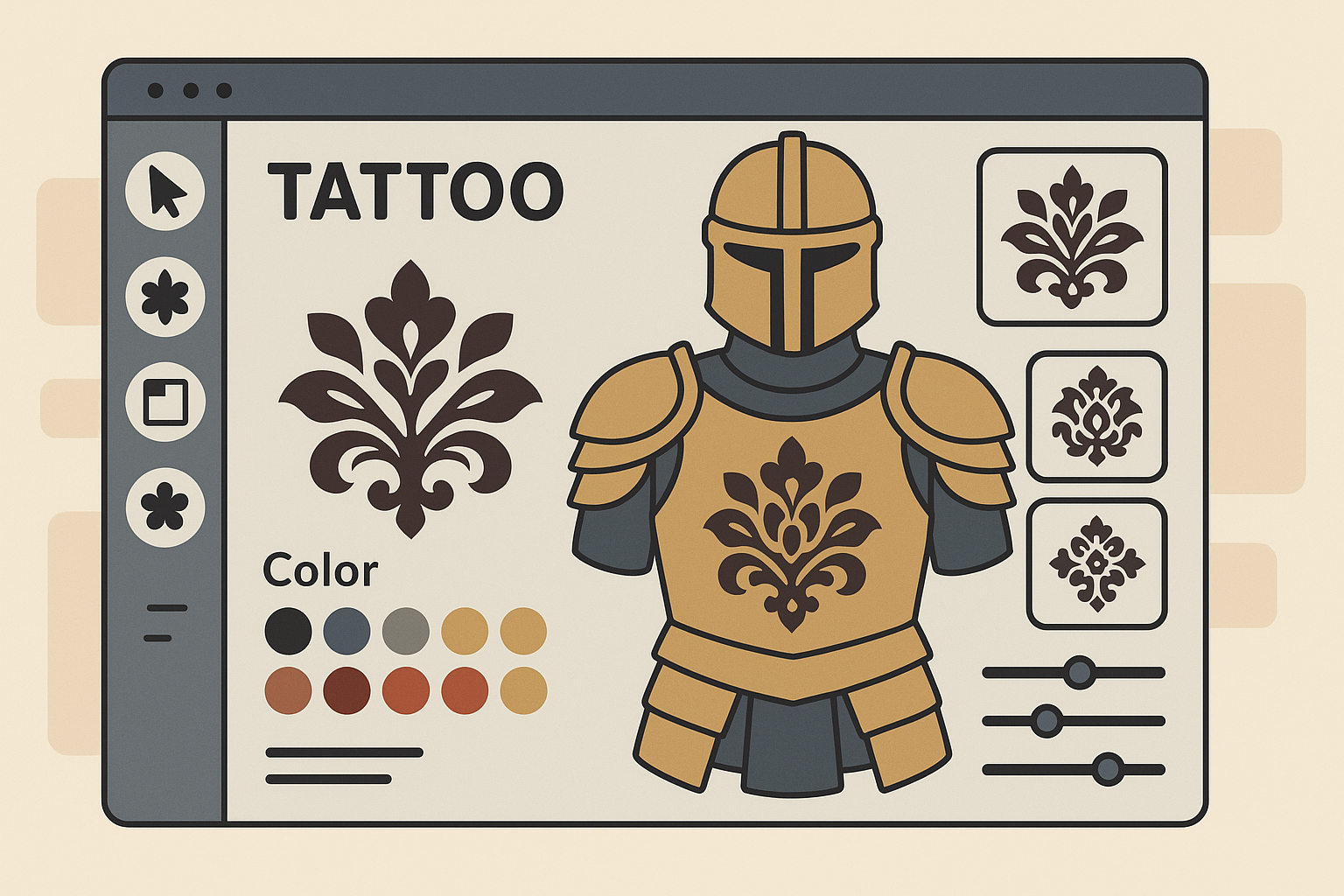25 Armor Tattoo Ideas That’ll Make You Feel Like a Walking Fortress
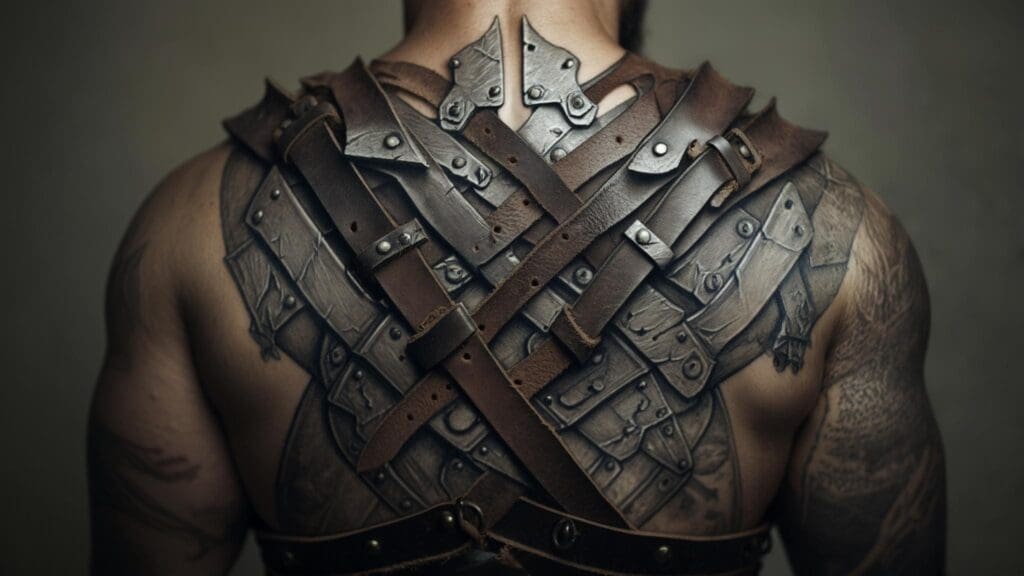
You know that feeling when you’re creating a character in a video game and you spend way too long getting their armor just right? I’m definitely guilty of this – I once stayed up until 3 AM tweaking every little detail on my character’s chest plate because something just didn’t look quite right. Turns out, I’m not alone in this obsession with protective gear that looks absolutely perfect. According to gaming statistics, armor-based character customization has increased by 340% in recent years, and that same attention to detail has spilled over into the tattoo world.
Armor tattoos aren’t just about looking tough (though they definitely do that). They’re about carrying that sense of protection and strength with you everywhere you go. Whether you’re drawn to historically accurate medieval plate mail or futuristic cyberpunk designs, armor tattoos offer a powerful way to express resilience and personal transformation through permanent art.
Table of Contents
- What You Need to Know Before Getting Started
- Classic Medieval Stuff (the knight in shining armor look) – 7 designs
- Fantasy & Sci-Fi Armor (when reality isn’t cool enough) – 6 designs
- Simple & Clean Approaches (less is more) – 5 designs
- Museum-Quality Realistic Pieces (the holy grail) – 4 designs
- Creative & Weird Combinations (thinking outside the box) – 3 designs
- The Technical Stuff That Actually Matters
- Where to Put It (and why it matters more than you think)
- Cultural Respect and Getting It Right
- How AI Can Help You Plan Your Design
- Final Thoughts
TL;DR
- Armor tattoos need serious skill and time (8-30+ hours depending on how detailed you go)
- Go big or go home – small armor tattoos just don’t work visually
- Do your homework on cultural stuff (samurai, Celtic, Norse) to avoid being disrespectful
- Black and gray usually ages better than color for that metallic look
- Work with your body’s shape, not against it
- These tattoos are perfect for building a full suit over time
- Not every artist can pull this off – choose wisely
What You Need to Know Before Getting Started
Before you jump into getting an armor tattoo, let’s talk about what you’re really signing up for. This isn’t like getting a small symbol on your wrist – armor tattoos are complex, time-consuming, and require finding the right artist who actually knows what they’re doing.
The Reality Check on Complexity
Here’s the thing about armor tattoos – they can range from super realistic (think museum-quality detail) to more artistic interpretations that capture the vibe without every rivet. If you want the realistic route, you’re looking at finding an artist who really knows their stuff when it comes to making metal look like actual metal on skin.
Understanding the pain levels involved is crucial when planning extensive armor tattoo sessions, because we’re talking about multiple long appointments here.
Let’s talk money, because I know that’s what you’re wondering about:
- Starting out: $300-1,000 for simpler designs (3-8 hours)
- Going bigger: $800-2,500 for detailed work (8-18 hours)
- Museum quality: $2,000-5,000+ for masterpiece-level stuff (15-30+ hours)
Yeah, it’s not cheap. But remember, you’re paying for someone to basically paint a masterpiece on your body that’ll last forever.
Size matters tremendously with armor tattoos. I can’t stress this enough – small pieces just don’t work. You can’t effectively show chainmail links or plate details in a 3-inch design. Most successful armor tattoos need significant real estate on your body to achieve their full impact.
Finding the Right Artist
Look, not every tattoo artist can pull off armor tattoos. It’s like asking a house painter to restore the Mona Lisa – they might be great at what they do, but this is specialized stuff. When you’re checking out artists, look for portfolios that show they can make metal look shiny, understand how shadows work on curved surfaces, and have done mechanical-looking pieces before.
Here’s a real example: Jake wanted a full sleeve of medieval plate armor tattoo. He initially chose an artist based on price alone, and it looked flat and fake. After expensive laser removal and a year of healing, he invested in a specialist who understood metallic textures. The second tattoo cost three times more but actually looked like convincing armor.
The best armor tattoo artists understand how armor actually works in real life. They know why certain design elements exist and how they’d function if they were real.
Cultural Stuff You Need to Know
This is important: if you’re thinking about samurai armor, Viking gear, or Celtic designs, do your homework first. These aren’t just cool-looking costumes – they’re tied to real cultures and histories. I’m not saying you can’t get them, but take some time to understand what you’re putting on your body and why it matters to the people whose ancestors wore this stuff.
Period-appropriate details make your armor tattoo look credible instead of like a Halloween costume. Whether you’re choosing medieval, Roman, or fantasy armor, authentic elements like proper riveting patterns and realistic proportions make all the difference.
What to Expect Long-Term
Fine details in armor tattoos might blur over time, so talk with your artist about balancing intricate details with line weights that will age well. Black and gray armor tattoos often age more gracefully than colored versions while keeping that metallic appearance longer.
Let’s be honest about what you’re signing up for. Armor tattoos hurt – especially the detailed ones that require multiple long sessions. Your shoulder’s going to be sore, you’ll probably need to take time off the gym, and yes, you might question your life choices around hour 6 of your session. But most people say it’s worth it once they see the final result.
Classic Medieval Stuff (The Knight in Shining Armor Look)
Medieval and historical armor tattoos are based on real protective gear that actual warriors wore into battle. These seven designs range from complete plate armor tattoos to specific pieces like Roman gear and Viking armor. Each one requires different levels of research and skill to pull off convincingly.
1. Full Plate Armor Sleeve
This is the big kahuna – a complete medieval armor sleeve tattoo from shoulder to wrist. We’re talking pauldrons (shoulder protection), arm guards, elbow protection, forearm pieces, and gauntlets with all the authentic joints and rivets.
When planning your sleeve tattoo cost, remember that armor sleeve tattoos cost more because they’re technically complex.
Expect 15-25 hours of work and exceptional skill requirements. The design has to account for how your arm moves and flexes, so the armor pieces stay proportional when your muscles contract. Battle wear details like strategic scratches and dents add authenticity and tell a story of combat experience.
2. Knight’s Shoulder Guard
A shoulder armor tattoo with layered plates and decorative elements is a great introduction to armor tattoos. Often includes chain mail underneath and leather strapping details, and you can incorporate personal symbols or meaningful elements.
The shoulder placement considerations are particularly important for shoulder armor tattoos, since this area really shows off the three-dimensional qualities that make armor designs so compelling.
This works great in both realistic and stylized approaches. The curved shoulder naturally fits the shape of a shoulder guard, creating a convincing three-dimensional look. Just remember that shoulder armor tattoos are highly visible, so consider how it’ll look from different angles.
3. Medieval Chest Plate
Chest armor tattoo designs follow your chest’s natural curve, often with a central ridge and decorative elements. You might include neck protection and hip guards for full torso coverage.
This needs careful planning to work with your chest muscle definition and natural body shape. The design should enhance your physique, not fight against it. Think about how the armor will look when you’re breathing and moving around.
4. Chainmail Sleeve Pattern
Intricate interlocking ring patterns that create the appearance of medieval chainmail armor. This requires precise geometric planning and consistent execution throughout the entire piece.
This is extremely time-intensive because of all the repetitive detail work. It’s best done by artists who specialize in geometric patterns. Properly rendered chainmail creates stunning visual texture, but it demands patience from both you and your artist.
5. Roman Centurion Armor
Features the distinctive segmented armor with horizontal plates, leather strips, and decorative elements specific to Roman military ranks.
Research specific legion markings and period-appropriate details for authentic representation. Roman armor gives you opportunities to incorporate personal meaning through historically accurate rank insignia and decorative elements.
6. Viking Lamellar Armor
Overlapping scale-like plates bound together, often combined with fur elements and Norse symbols. There’s less historical documentation for this style, but it creates a visually striking approach to Viking warrior aesthetics.
You can incorporate runes, Norse mythology symbols, and period-appropriate decorative elements. The organic flow of the scales works well with body contours while maintaining that fierce warrior appearance.
7. Samurai Chest Armor
Traditional Japanese chest armor featuring laced plates, family crests, and that distinctive silhouette. Often combined with shoulder guards and other traditional elements.
This requires respectful research and understanding of samurai traditions and symbolism. The elegant curves and sophisticated construction methods of samurai armor create opportunities for both artistic beauty and cultural appreciation.
Fantasy & Sci-Fi Armor (When Reality Isn’t Cool Enough)
Fantasy and sci-fi armor tattoos let you break free from what’s historically possible and explore imaginative protective gear that couldn’t exist in reality. These six designs range from organic dragon scale armor to high-tech cyberpunk gear, giving you opportunities for unique color work and innovative artistic techniques while keeping that protective symbolism.
8. Dragon Scale Armor
Organic-looking armor that mimics dragon scales gives you tons of creative freedom. It can look like natural dragon hide or crafted scale mail with color gradients and mythical elements.
Each scale needs careful attention – proper highlights and shadows for dimensional effect. Scale size should vary naturally, bigger at shoulders and smaller toward your hands. Color transitions from deep emerald to gold or classic red to black create stunning visual impact.
Maria chose dragon scale armor for her back piece, working with her artist to create scales that shifted from deep purple at her shoulders to gold at her lower back. The organic flow followed her spine’s natural curve, and each scale was individually shaded to create the illusion of overlapping protective layers. The 18-hour piece took three sessions but resulted in armor that seemed to grow naturally from her skin.
9. Cyberpunk Mechanical Armor
Futuristic armor featuring exposed mechanical components, LED-style lighting effects, and high-tech materials. Often includes circuit patterns and tech interfaces that appeal to gaming and sci-fi enthusiasts.
Component details include exposed hydraulics, LED strip effects (rendered in bright white/blue), circuit board patterns, ventilation grilles, and modular connection points. Material rendering combines brushed steel, carbon fiber patterns, glowing energy cores, and weathered metal showing technological wear.
10. Steampunk Brass Armor
Victorian-era inspired mechanical armor with brass components, gears, rivets, and steam-powered elements. Combines historical aesthetics with fantastical functionality.
This requires skill in rendering both metallic textures and mechanical components convincingly. The warm brass tones contrast beautifully with darker steel elements, while visible gears and steam vents add mechanical authenticity to the fantasy concept.
11. Elven Ceremonial Armor
Elegant, nature-inspired armor with organic curves, leaf patterns, and ethereal design elements. Often incorporates natural materials like wood and precious metals.
You need to balance fantasy elements with armor functionality for a believable design. The flowing, organic lines work particularly well with body contours while maintaining the protective symbolism essential to armor tattoos.
12. Demonic/Dark Fantasy Armor
Dark fantasy armor with spikes, skulls, and otherworldly elements. Often includes supernatural materials and intimidating design features that create dramatic visual impact.
This requires careful balance between dramatic impact and tasteful execution. The design should feel powerful and protective rather than purely aggressive, maintaining the armor’s symbolic meaning while exploring darker aesthetic territory.
13. Crystal/Gem-Encrusted Armor
Fantasy armor incorporating magical crystals, gemstones, and energy effects. Can include glowing elements and supernatural properties that showcase advanced color work skills.
This is an excellent opportunity for creating unique visual effects through strategic color placement and energy representations. The interplay between solid armor elements and translucent crystal components creates compelling visual depth.
Simple & Clean Approaches (Less Is More)
Minimalist and stylized armor tattoos strip away excessive detail to focus on essential protective symbolism through clean lines and bold shapes. These five designs appeal to people who prefer contemporary aesthetics while maintaining armor’s powerful meaning, offering more accessible entry points into armor tattoos with shorter execution times and broader artist availability.
14. Geometric Armor Plating
Simplified armor tattoo designs using clean geometric shapes and minimal line work focus on essential armor elements without excessive detail. This modern aesthetic appeals to people who prefer contemporary, clean design approaches.
Uses negative space effectively to imply protection through strategic shape placement. Consistent line weight throughout creates visual harmony while asymmetrical balance with 3-5 primary shapes suggests armor across shoulder and upper arm.
15. Tribal-Style Armor Patterns
Armor tattoo designs interpreted through tribal tattoo aesthetics combine armor symbolism with traditional tattoo styles. Uses bold black work and traditional tribal design principles for unique fusion results.
Understanding tribal tattoo meanings helps ensure your armor tattoo design respects traditional symbolism while creating something uniquely protective.
Traditional tribal motifs adapt to suggest armor forms while maintaining that tribal aesthetic. Bold black work using solid shapes and flowing lines needs minimum 4-inch width to maintain pattern clarity and visual impact.
16. Minimalist Shoulder Guard
Simple, clean-lined shoulder protection using only essential design elements. Focus on shape and proportion rather than intricate details creates a versatile piece that works well alone or as part of a larger composition.
Success depends on perfect proportions and clean execution. The simplified approach lets the armor’s symbolic meaning shine through without distraction from excessive detail.
17. Abstract Armor Fragments
Deconstructed armor elements arranged artistically rather than functionally emphasize the aesthetic and symbolic aspects of protection. Allows for creative interpretation while maintaining armor symbolism.
This artistic freedom enables unique personal expression while preserving the protective meaning that makes armor tattoos meaningful. The abstract approach can incorporate personal elements more easily than realistic designs.
18. Silhouette Armor Design
Armor tattoo designs rendered as bold silhouettes with minimal internal detail rely on shape recognition and symbolic power. Creates strong visual presence with simplified execution requirements.
Bold impact through simplified execution makes these designs accessible to a broader range of artists while maintaining the powerful symbolism that draws people to armor tattoos.
Museum-Quality Realistic Pieces (The Holy Grail)
Realistic armor tattoos represent the highest level of technical achievement in armor tattoo artistry, requiring master-level skills in metallic texture rendering, understanding how light behaves, and historical accuracy. These four designs demand significant time investment and premium pricing but deliver museum-quality artwork that rivals fine art paintings in their technical execution and visual impact.
19. Battle-Worn Plate Armor
Hyperrealistic armor showing battle damage, wear patterns, and authentic aging includes dents, scratches, and realistic weathering effects that tell stories of combat experience.
Requires advanced shading skills and understanding of metal behavior under stress. Strategic dent placement shows realistic battle damage while scratches follow metal grain direction. Edge wear on high-contact areas adds authenticity through careful observation of how armor actually ages.
David’s battle-worn shoulder plate armor tattoo took 20 hours across four sessions. His artist studied actual medieval armor in museums to understand how metal dents and scratches under combat stress. The final piece showed realistic battle damage including a prominent dent from a mace strike, scratches from sword contact, and edge wear from daily use. The weathering patterns told a complete story of a warrior’s career, making the tattoo feel like a historical artifact rather than mere decoration.
20. Polished Steel Reflection Armor
Pristine armor showcasing mirror-like surfaces, reflections, and perfect metallic finish demonstrates the armor’s protective beauty through technical mastery.
Demands exceptional skill in rendering reflective surfaces and metallic textures. Environmental reflections suggest sky, clouds, or surrounding architecture while specular highlights using white ink over healed black work create convincing mirror effects.
21. Anatomically Correct Historical Armor
Museum-quality accuracy in historical armor representation includes proper proportions, authentic construction methods, and period-appropriate details that honor historical craftsmanship.
Requires extensive historical research and attention to authentic details. Each element must reflect actual armor construction methods and proportional relationships found in museum pieces and historical documentation.
22. Layered Armor Construction
Detailed representation showing how armor pieces layer together includes padding, straps, and functional elements beneath outer plates, demonstrating understanding of actual armor construction.
Educational value shows the complexity of real armor systems while creating visually compelling depth through multiple layers. The technical accuracy appeals to history enthusiasts and armor aficionados.
Creative & Weird Combinations (Thinking Outside the Box)
Hybrid and creative armor concepts push the boundaries of traditional armor tattoo design by combining organic and mechanical elements, incorporating supernatural forces, or showing dynamic transformation states. These three innovative approaches require conceptual complexity and advanced artistic skills while offering unique opportunities for personal expression through unconventional armor interpretations.
23. Bio-Mechanical Armor Fusion
Armor that appears to grow from or integrate with the body combines organic and mechanical elements. Often includes exposed muscle, bone, or technological implants that blur the line between natural and artificial protection.
Requires understanding of both anatomy and mechanical design principles. The conceptual complexity challenges both artist and viewer while creating deeply personal protective imagery that feels truly integrated with the wearer’s body.
24. Elemental Armor Integration
Armor that incorporates or channels elemental forces like fire, ice, lightning, or earth shows the armor as a conduit for supernatural powers.
Opportunities for unique color work and energy effect representations create visually stunning pieces. The supernatural elements add personal meaning while maintaining the protective symbolism central to armor tattoos.
25. Transforming/Modular Armor
Armor that appears to be changing, assembling, or reconfiguring can show different states of transformation or modular components in motion.
Creates a sense of movement and change within the static tattoo medium. Dynamic design suggests growth, adaptation, and evolution – powerful personal metaphors enhanced by the protective symbolism of armor.
The Technical Stuff That Actually Matters
Understanding the technical demands and quality levels of different armor tattoo approaches helps you make informed decisions about time investment, cost expectations, and artist selection. This breakdown of the 25 designs into skill tiers explains what each level requires in terms of artistic expertise, session time, and long-term maintenance to help you choose designs that match your budget and expectations.
| Design Category | Skill Tier | Session Count | Touch-up Frequency | Best For |
|---|---|---|---|---|
| Simple/Stylized | Accessible | 1-2 sessions | Every 7-10 years | First-time armor tattoos |
| Fantasy/Sci-Fi | Professional | 2-4 sessions | Every 5-7 years | Creative expression |
| Realistic/Historical | Master | 3-6 sessions | Every 3-5 years | Serious collectors |
Master-Level Requirements
Designs 1, 3, 19-22 require master-level artistry with 10+ years experience and portfolios demonstrating metalwork expertise. Time investment ranges 15-30 hours across 3-6 sessions with cost expectations of $2000-5000+ depending on size and artist reputation.
These pieces require touch-ups every 5-7 years to maintain detail clarity. The investment reflects the exceptional skill level and time commitment needed to achieve museum-quality results that will satisfy you for decades.
Professional Standards
Designs 2, 4-13, 23-25 need 5+ years experience with demonstrated technical skills in chosen style. Time investment spans 8-18 hours across 2-4 sessions with cost expectations of $800-2500 depending on complexity.
Minimal touch-ups needed if properly executed initially. These designs offer excellent balance between visual impact and reasonable investment for most tattoo collectors seeking high-quality armor tattoos.
Accessible Options
Designs 14-18 require 2+ years experience with strong foundational skills. Time investment spans 3-8 hours, often completable in 1-2 sessions with cost expectations of $300-1000 depending on size.
Age gracefully due to bold design elements that maintain their visual impact over time. These designs provide excellent entry points into armor tattoos without overwhelming technical or financial demands.
Where to Put It (And Why It Matters More Than You Think)
Strategic placement maximizes your armor tattoo’s visual impact by working with your body’s natural anatomy rather than against it. This section explores how different body areas accommodate various armor tattoo designs, considering muscle definition, movement patterns, and expansion opportunities to ensure your tattoo looks convincing and ages well over time.
Consider the cost implications of different placements when planning your armor tattoo, as larger pieces in premium locations command higher prices.
| Body Area | Best Armor Types | Expansion Potential | Visibility Level | Movement Considerations |
|---|---|---|---|---|
| Shoulder | Pauldrons, Guards | High (arm/back) | High | Muscle flexion |
| Chest | Breastplates, Cuirass | Medium (back/arms) | High | Breathing, muscle definition |
| Back | Full armor systems | High (shoulders/arms) | Low-Medium | Minimal movement issues |
| Arms | Sleeves, Bracers | High (chest/back) | High | Constant flexion |
Shoulder Placements
Natural fit for shoulder guards that work with deltoid muscle definition. Allow for future expansion down the arm armor tattoo or across the back while providing excellent visibility for detailed work.
Think about how the design will look from multiple angles since shoulder tattoos are highly visible. The curved shoulder surface naturally accommodates armor pieces, creating convincing three-dimensional appearance when properly executed.
Arm Coverage Applications
Full sleeve armor tattoos or partial sleeve approaches can incorporate multiple armor elements that flow together cohesively. Consider how designs will look with arm movement and muscle flexion – armor should enhance your physique rather than distort during normal movement.
Upper arm placement works excellently for larger armor pieces while forearm placement suits detailed elements like gauntlets or bracers. Plan the flow between different armor components for seamless integration.
Chest Applications
Chest plates and torso armor work with natural body contours but must account for chest hair, muscle definition, and breathing movement. The large canvas area allows for impressive armor pieces that command attention.
Consider how the design interacts with your natural chest shape and muscle definition. Proper planning ensures the armor enhances your physique while maintaining realistic proportions and authentic appearance.
Back Opportunities
Large canvas area perfect for full armor back pieces, wing-like designs, or comprehensive armor systems spanning the entire back. Offers excellent space for detailed work and complex compositions.
Back placement allows for ambitious armor tattoo designs that would be impossible on smaller body areas. Consider how the design will look when partially visible and plan for impressive reveal potential.
Cultural Respect and Getting It Right
Respectful representation of culturally specific armor requires research, understanding, and genuine appreciation rather than superficial aesthetic borrowing. This section guides you through approaching different armor traditions with appropriate respect while avoiding cultural appropriation, ensuring your tattoo armour honors rather than exploits the rich heritage behind various armor styles.
Respectful Representation Guidelines
When choosing culturally specific armor (samurai, Celtic, Norse), research the historical context and symbolic meaning. Avoid stereotypes or inaccurate combinations of elements from different periods or cultures that show lack of understanding or respect.
Authentic personal connection enhances the tattoo’s meaning and appropriateness. Consider your own heritage or genuine interest in specific cultures rather than choosing based solely on aesthetic appeal.
Historical Context Understanding
Each armor tradition carries deep cultural significance beyond visual appeal. Samurai armor represents honor, discipline, and spiritual warrior principles. Celtic armor connects to tribal identity and ancestral protection. Norse armor embodies exploration, courage, and mythological beliefs.
Research the meaning behind specific armor elements to create meaningful rather than superficial representations. Understanding the cultural context enriches your tattoo’s personal significance while showing respect for the tradition.
Avoiding Appropriation
Cultural appropriation occurs when sacred or significant cultural elements are used without understanding or respect. Avoid mixing elements from different cultures inappropriately or using sacred symbols without understanding their meaning.
Consult cultural experts or community members when uncertain about appropriateness. Respectful appreciation involves learning about and honoring the culture rather than simply borrowing its visual elements.
How AI Can Help You Plan Your Design
If you’re struggling to visualize your idea or communicate it to an artist, AI tools like Tattoo Generator IQ can help you mock up designs before you commit. It’s basically like having a sketch artist who never gets tired and can try a million variations until you find something that clicks.
The complexity and personal significance of armor tattoos make them perfect candidates for AI-assisted design exploration. Our platform’s sophisticated AI understands the technical demands of armor tattoos, generating designs that account for metallic textures, proper proportions, and realistic lighting effects essential for convincing armor representation.
Our AI tattoo generator technology specifically excels at creating armor tattoo designs that respect both artistic vision and technical requirements.
Professional Visualization Capabilities
Generate designs that respect both artistic vision and functional armor principles. Our AI grasps the mechanical requirements of armor tattoo design – proper joint articulation, realistic proportions, and authentic material rendering that professional tattoo artists need for successful execution.
High-resolution outputs include technical specifications that help your tattoo artist understand your vision completely. Bridge the gap between digital concept and physical reality with detailed reference materials and placement guides.
Cultural Education Resources
Access educational resources about historical armor traditions, cultural significance, and respectful representation practices. Our platform helps you navigate the cultural aspects of armor from different traditions while avoiding appropriation.
Comprehensive guides help you understand the cultural significance, historical context, and technical requirements of different armor styles, ensuring your tattoo choice is both beautiful and respectful.
Style Innovation Tools
Seamlessly blend historical accuracy with personal creativity using our custom style blending features. Combine medieval authenticity with modern aesthetics, or merge traditional armor elements with contemporary artistic styles for truly unique results.
Explore multiple variations, test different color schemes, and refine details before committing to permanent ink. Our platform supports the careful planning that armor tattoos require through iterative design processes.
Ready to forge your perfect armor tattoo design? Visit Tattoo Generator IQ today and begin creating designs that embody strength, protection, and personal transformation through the timeless symbolism of warrior armor.
Final Thoughts
Armor tattoos represent more than decorative body art – they’re powerful statements of personal strength, protection, and transformation. The 25 designs we’ve explored offer pathways for every skill level, budget, and aesthetic preference, from historically accurate medieval shoulder armor tattoos to innovative bio-mechanical fusions that push artistic boundaries.
Whether you’re considering your first tattoo experience or adding to an existing collection, armor tattoos offer unique opportunities for meaningful self-expression.
What if I change my mind? Look, armor tattoos are big commitments. If you’re having doubts, sit on the idea for a few months. Get some temporary tattoos, live with the concept. Better to wait than regret.
Will it look stupid when I’m older? Honestly? A well-done armor tattoo ages better than most designs because the weathered, battle-worn look actually works in your favor as the tattoo ages.
Your armor tattoo journey requires careful consideration of technical demands, cultural sensitivity, and long-term satisfaction. The investment in time, money, and research pays dividends through decades of meaningful personal symbolism that grows more significant over time. Whether you choose the accessible elegance of minimalist geometric plating or commit to the exceptional artistry of battle-worn plate armor tattoos, your choice should reflect genuine personal connection rather than fleeting aesthetic trends.
Remember that the best armor tattoos work with your body armor tattoo placement strategy while honoring the rich traditions behind protective symbolism. Take time to research, plan carefully, and choose an artist whose skills match your vision’s technical demands. Your armor tattoo will become part of your personal story – make sure it’s a chapter you’ll be proud to carry forever.
